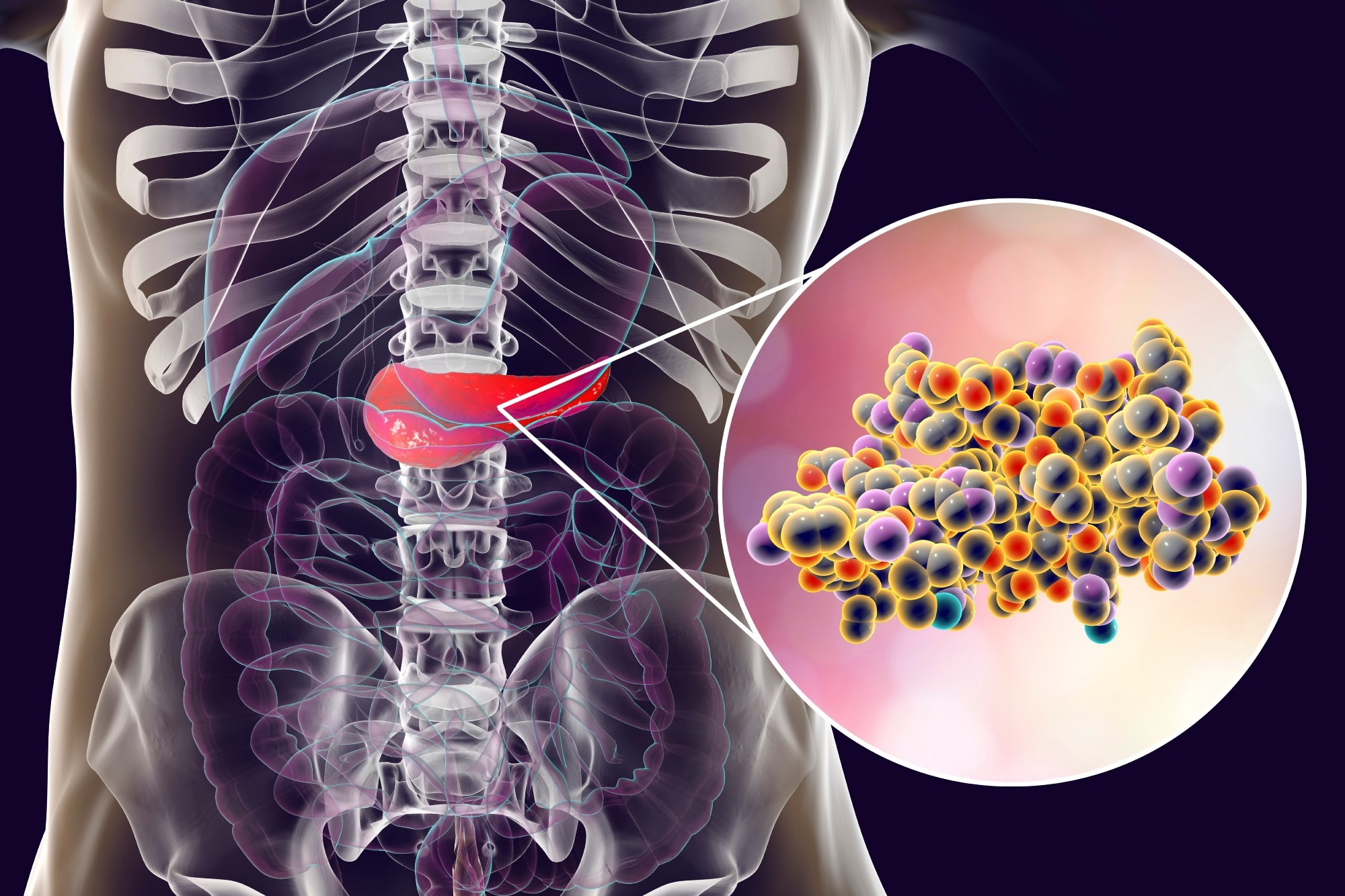A new study uncovers how endothelial cells contribute to insulin resistance in obesity-associated diabetes, highlighting adrenomedullin as a potential therapeutic target.
 Study: Endothelial insulin resistance induced by adrenomedullin mediates obesity-associated diabetes. Image Credit: Kateryna Kon / Shutterstock.com
Study: Endothelial insulin resistance induced by adrenomedullin mediates obesity-associated diabetes. Image Credit: Kateryna Kon / Shutterstock.com
A recent study published in Science investigates the underlying mechanisms of endothelial insulin resistance involved in obesity-associated diabetes.
What causes insulin resistance?
Diabetes is a chronic disease that occurs when the body cannot adequately produce or use insulin, a hormone that facilitates the transportation of glucose from the blood into cells for energy. The activation of insulin receptors, which are highly expressed on the luminal side of endothelial cells, induces endothelial nitric oxide (NO)-synthase (eNOS) activity. Subsequently, NO-mediated vasodilation allows insulin to reach metabolic target cells including adipocytes, skeletal muscle cells, and hepatocytes.
Excess glucose levels in the blood can lead to insulin resistance, which primary affects these target cells. Previous in vivo studies have revealed that endothelium-specific loss of the insulin receptor or insulin receptor substrate 2 leads to reduced insulin sensitivity due to weakened insulin effects on adipose tissue and skeletal muscles, but not the liver.
In addition to diabetes, insulin resistance also increases the risk of several other diseases including cardiovascular disease, non-alcoholic steatohepatitis, cancer, and neurodegenerative disease. Thus, it is crucial to elucidate the precise mechanisms involved in endothelial insulin resistance to devise novel strategies to prevent and treat this condition.
About the study
The researchers of the current study conducted several in vitro experiments using human umbilical venous endothelial cells (HUVECs) and human adipose tissue microvascular endothelial cells (HATMVECs) to identify a G protein-coupled receptor (GPCR) that likely operates upstream of the guanosine triphosphate (GTP)-binding Gs protein in endothelial cells and its involvement in insulin signaling inhibition. To this end, small interfering ribonucleic acid (siRNA) knockdown of 16 GPCRs was performed, followed by protein quantification and phosphorylation and insulin activity assays.
For the in vivo studies, the background of C57BL/6J mice were used to generate inducible endothelium-specific Gαs-deficient, endothelium-specific calcitonin receptor-like receptor (CALCRL)- and adrenomedullin-deficient mice. Cre-mediation was induced by tamoxifen treatment for five consecutive days.
Mice were fed a high fat diet (HFD) for 16 weeks to induce obesity and systemic insulin resistance. For the glucose tolerance test (GTT), mice were fasted for six hours before injected with 1.5 mg glucose/gram of body weight for HFD-fed mice and 2.0 mg glucose/gram for control mice consuming a standard normal chow diet.
Mice were also subjected to an insulin tolerance test (ITT), in which mice that were fasted for six hours were subsequently injected with 0.75 units/kg of human insulin, following which blood glucose levels were monitored at 15, 30, 60, and 120 minutes.
Study findings
In vitro siRNA experiments demonstrated that Gαs and CALCRL knockdown of HUVECs led to increased insulin-induced eNOS and AKT phosphorylation, as well as insulin-induced formation of NO. Likewise, knockdown of adrenomedullin led to increased insulin-induced insulin receptor phosphorylation.
Although adrenomedullin can induce some phosphorylation of eNOS in the absence of insulin, in the presence of a insulin…adrenomedullin inhibits insulin receptor phosphorylation and downstream signaling.”
In endothelial cells, both CALCRL and receptor activity-modifying protein 2 (RAMP2) function as receptors for adrenomedullin. Adrenomedullin, which is highly expressed in endothelial cells, can induce eNOS activation following protein kinase A (PKA) inhibition.
PKA signaling can increase the activity of protein-tyrosine phosphatase 1B (PTP1B), a phosphotyrosine phosphatase that dephosphorylates the insulin receptor at tyrosine residues 1162 and 1163, both of which underwent autophosphorylation following Gαs knockdown. Whereas insulin treatment inhibited PTP1B activity, adrenomedullin increased basal PTP1B activity and prevented its inhibition following insulin treatment. Notably, this activity is dependent on PKA, as demonstrated by treatment with the PKA inhibitor peptide PKI, which blocked this activity by adrenomedullin. These findings suggest the role of adrenomedullin in inhibiting insulin-induced insulin receptor phosphorylation by increasing PTP1B activity.
In vivo experimental findings revealed that the loss of endothelial adrenomedullin receptor Gs signalling increases insulin-induced insulin receptor activation, thereby improving insulin sensitivity, insulin-induced receptor phosphorylation, and downstream signaling in obese mice with T2D.
As compared to unchanged eNOS phosphorylation observed in the tissues of normal chow-fed mice treated with insulin, both Gαs- and CALCRL-knockout mice exhibited high nitrate and nitrite plasma levels. Reduced insulin-induced endothelial eNOS activation and skeletal muscle perfusion was also observed in obese mice and likely the result of Gs-coupled adrenomedullin receptor activation.
Increased plasma levels of adrenomedullin were observed in obese mice as compared to normal chow-fed mice, which was attributed to increased adrenomedullin produced by adipocytes. Obese mice lacking adrenomedullin, as well as those treated with the adrenomedullin receptor antagonist peptide ADM, exhibited improved glucose tolerance and insulin sensitivity.
Conclusions
The current study highlights the role of endothelial cells in promoting insulin resistance in T2D. Endothelial insulin resistance in obese individuals with T2D is associated with elevated plasma levels of adrenomedullin and CFH; therefore, blocking the endothelial adrenomedullin receptor and downstream signaling events can effectively treat systemic insulin resistance observed in obesity.
Considering these findings, adrenomedullin-induced and Gs/PKA-based endothelial inhibition of insulin receptor phosphorylation could be used as a therapeutic target to prevent and treat insulin resistance.
Journal reference:
- Cho, H., Lai, C., Bonnavion, R., et al. (2025) Endothelial insulin resistance induced by adrenomedullin mediates obesity-associated diabetes. Science 387(6723);674-682. doi:10.1126/science.adr4731